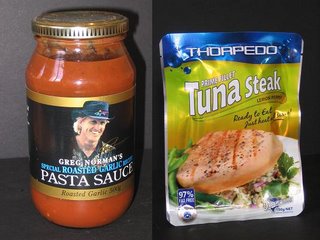
My lecture on "leveraging secondary brand assoc- iations" (by linking a brand to an entity like a celebrity, a country of origin, another brand, etc.) was still fresh in my mind the other night as I relaxed in front of the TV. Totally without warning, former One Nation leader and ex-con Pauline Hanson - one of the most divisive figures in recent Australian cultural history - appeared in the middle of an ad for Donut King, asking me something along the lines of "What do you feel like?".
Well, I'm happy to say that I felt like a fool - what would my students think? What would they ask me in next week's class if they'd seen this bizarre campaign? Surely all that stuff I'd been saying about marketers choosing celebrity endorsers for the beneficial secondary associations they bring to the brand must be complete rubbish?!
At first, I thought that I would have to explain it away as just another clearly bad choice - like (pictured) Ian Thorpe's THORPEDO tuna steaks or Greg Norman's pasta source (well Paul Newman did it... Greg Norman is near enough, isn't he?). And there are plenty of examples of using a celebrity - especially a notorious one like Mark "Chopper" Read - simply to get attention.
But then I started to wonder...
What if Donut King actually does want to tap into the network of brand associations that we hold (or some of us hold) about Pauline Hanson? Which of those associations could they possibly regard as potentially beneficial to the Donut King brand?
At a rational, brand performance level, there's nothing to go on - Pauline is vaguely known as a former fish and chip shop owner, but not a renowned expert on donuts whose endorsement would matter to us: Wow, she really knows donuts, so for her to put her name to those Donut Kings really means something! No, I think not. Homer Simpson comes to mind more readily (and would probably be a better electoral bet than Pauline these days, too).
It can't be about user imagery, surely? For how many Australians does Pauline Hanson have aspirational appeal? She's not exactly renowned for her good taste, so I consider it doubtful that there's anyone who would feel better eating a Donut King donut now that they know it's Pauline's choice.
So it must be more to do with linking to emotions, attitudes and perhaps even values that we associate with Pauline Hanson... and that, of course, is very dangerous territory. Perhaps it's an attempt to position the gaudy pink donut - iced with "hundreds and thousands" - firmly in the 1950s version of Australian cultural life that Ms Hanson seems to favour, alongside fairy bread at a kids' party, an Iced Vo-Vo biscuit, Bob Menzies in Canberra and the "yellow peril" still a few thousand miles to the north. Multiculturalism? Why, we've got all the diversity you'll ever need right here at the donut counter!
(By the way, donuts and multiculturalism are not mutually exclusive - I often enjoy an Italian style bomboloni with apricot jam filling from Caffe di Lusso in Glenferrie Road, Hawthorn.)
Another thought: maybe it's about protecting Australian interests against foreign takeovers of our markets. With business travellers still queuing to buy boxes of Krispy Kreme doughnuts at Sydney Airport, Melbourne's first KK store located at Fountain Gate (right in "Kath & Kim" territory), and KK's fund-raising program earning them tremendous kudos with community organisations, maybe Donut King is trying to send out a subtle call to patriotism (or xenophobia) by linking themselves to such a prominent anti-immigration, "White Australia" campaigner?
Or maybe I'm missing something more obvious. Perhaps, as a prominent Royalist, it's logical that Ms Hanson would support anything with "King" in the title: stand by for Pauline as spokesmodel for Burger King or King Oscar Sardines.
Better still, there's one product endorsement opportunity that would neatly combine her racist attitudes with support for royalty and good old fashioned Australian values: White King bleach.

